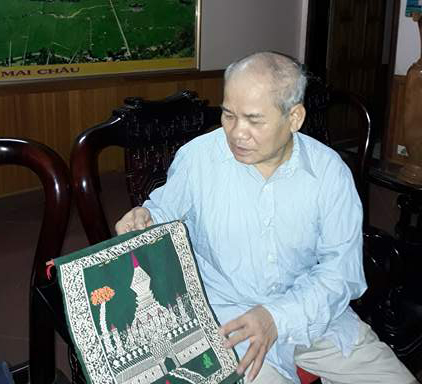
(HBO) – These days, whenever watching TV programmes featuring activities to celebrate the Vietnam-Laos Friendship and Solidarity Year 2017, Ha Van Tuan, former Chairman of the People’s Committee of Mai Chau district, Hoa Binh province, is always filled with sentiments that is difficult to describe with words. Only those who visited the nation of Champa flower can understand these feelings when hearing the names of destinations and people of the country.
Meeting Tuan in a morning in July in Mai Chau town,
Mai Chau district, and listening to his stories, we know that his days in
Laos have
become sacred and priceless memories.

A brocade with That Luang tower embroidery - the
symbol of
Laoshas been preserved by Ha Van Tuan.
In late 1983, Tuan was surprised with delight to be
sent from Mai Chau Agriculture Office to the provincial Committee for
Economic-Cultural Cooperation with
Laos. He was dispatched to Luang
Phrabang to help the province build a pilot agricultural cooperative and
develop high productivity rice varieties. This was part of the economic and
cultural affilication programmes of the two twinned provinces of former Ha Son
Binh province and Luang Phrabang of
Laos.
He was a little nervous when arriving in the country
with strange geographic names, such as the Tay Trang border gate, Nam Bac, Nam
U, and Mekong River, but he became confident with his fluent Thai language. His
team included some leaders of the district, officials of Van Mai commune’s
agricultural cooperative as well as construction and architecture companies.
At that time,
Vietnamwas on a subsidy period with many difficulties, but the living conditions in
Laos were even
more difficult. Locals in the country faced many problems, especially low literacy
and the spreading of malaria, along with poor infrastructure system and tough
roads.
Sharing difficulties facing locals, Tuan and other
members of the working group were resolved to make all-out efforts in order to
help them practically. The first job was to understand local geography as well
as cultivation and production conditions in the locality. Thanks to support of
Lao friends, the working group had many chances to visit hamlets and districts
in Luang Prabang to learn about locals’ farming methods. They, therefore,
proposed using only organic fertilizers, not using or using a small amount of
chemical fertilizers, aiming to generate productivity equal or higher than the
traditional farming methods which used a lot of chemical fertilizers. The proposals
were agreed by their superiors. They helped agricultural officials in Luang
Prabang conduct experiments on rice varieties in order to select suitable
varieties to plant in the locality. With the passion, Tuan rode a bicycle to
the Pak-Suong centre of rice varieties to work together with local agricultural
officials to create new rice varieties. His efforts paid off as productivity
was improved and local agricultural officials and farmers got used to the
advanced farming methods. Tuan collected a lot of memories after the three-year
working trip, from travelling hundreds of km to the experimental centre to
conversations with farmers in Na Sang, Khoi and Pong Van hamlets in Sang Kha
Loc commune to exchange farming experience, or with Lao friends such as Bun
Thin, Hum Phenh, Lot-vi Say, Phu Ma and Kham Keo.
After the re-establishment of Hoa Binh province, Tuan had a chance to
return
Vientianeand Luang Prabang. He was delighted to see changes in UNESCO-recognised Luang
Prabang city and meet with his Lao friends. The city has maintained its
hospitality and lifestyle in the 1980s, which has made it become more beautiful
and memorable. Tuan and other officials of former Ha Son Binh province
contributed to developing the twining relationship between Ha Son Binh and
Luang Prabang provinces as well as between
Vietnamand
Laosin general.
Bui Huy
More than just an information technology teacher, Bui Van Nien is an inspiring figure who has nurtured the scientific curiosity and creative spirit of students in Vietnam’s ethnic minority communities.
Da Bac is the most disadvantaged mountainous district in Hoa Binh province, with ethnic minorities accounting for about 90% of its population. Over the past years, the district has mobilised resources to implement ethnic policies to improve the quality of life of local people.
In recent years, Hoa Binh province has consistently prioritised the protection, care, and education of children, particularly those from ethnic minorities and disadvantaged backgrounds, by creating a safe, healthy, and nurturing environment for their all-round development.
The Steering Committee for Tobacco Harm Prevention and Control of Hoa Binh province, in coordination with the Tobacco Harm Prevention and Control Fund, held a ceremony on May 28 in response to the World No Tobacco Day (May 31) and the National No Tobacco Week (from May 25 to 31). The event was chaired by Nguyen Van Toan, Standing Vice Chairman of the provincial People’s Committee and head of the Steering Committee.
Since 2021, the Center for Industrial Promotion and Industrial Development Consulting (CIIDC) under the Department of Industry and Trade has been implementing a school lighting model as part of the plan for using energy efficiently and economically in Hoa Binh Province in the pẻiod of 2021 - 2025. This model not only aims to improve the learning conditions and enhance the education quality, but it also promotes the message of energy saving, energy security, environmental protection and contributes to the goals of socio-economic development.
In the 2024 - 2025 school year, the entire Hoa Binh provincial education sector includes 520 educational institutions and schools. Among them are 13 ethnic boarding schools with 153 classes and 4,487 students. Four of these schools have met national standards, reaching 30.7 percent.



